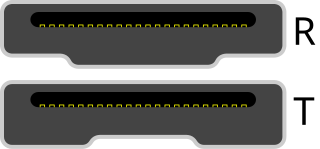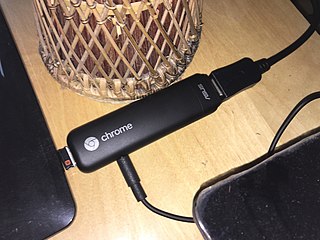
Digital Visual Interface (DVI) is a video display interface developed by the Digital Display Working Group (DDWG). The digital interface is used to connect a video source, such as a video display controller, to a display device, such as a computer monitor. It was developed with the intention of creating an industry standard for the transfer of uncompressed digital video content.
A DVD player is a device that plays DVDs produced under both the DVD-Video and DVD-Audio technical standards, two different and incompatible standards. Some DVD players will also play audio CDs. DVD players are connected to a television to watch the DVD content, which could be a movie, a recorded TV show, or other content.
Extended Display Identification Data (EDID) and Enhanced EDID (E-EDID) are metadata formats for display devices to describe their capabilities to a video source. The data format is defined by a standard published by the Video Electronics Standards Association (VESA).

High-Definition Multimedia Interface (HDMI) is a proprietary audio/video interface for transmitting uncompressed video data and compressed or uncompressed digital audio data from an HDMI-compliant source device, such as a display controller, to a compatible computer monitor, video projector, digital television, or digital audio device. HDMI is a digital replacement for analog video standards.
High-bandwidth Digital Content Protection (HDCP) is a form of digital copy protection developed by Intel Corporation to prevent copying of digital audio and video content as it travels across connections. Types of connections include DisplayPort (DP), Digital Visual Interface (DVI), and High-Definition Multimedia Interface (HDMI), as well as less popular or now deprecated protocols like Gigabit Video Interface (GVIF) and Unified Display Interface (UDI).
MovieBeam was a video on demand service started by The Walt Disney Company, specifically its subsidiary Buena Vista Datacasting, LLC. Movies were sent wirelessly into the subscriber's home by embedding digital data (datacasting) within local Public Broadcasting Service (PBS) stations' analog TV (NTSC) broadcast to deliver the movies to a set-top box. The data was embedded using dNTSC technology licensed from Dotcast, and distributed to TV stations via National Datacast through the vertical blanking interval, the same method used to provide closed captioning. Up to ten new movies were delivered to the player each week. The player also contained free movie trailers, previews, and other extras.

DisplayPort (DP) is a digital display interface developed by a consortium of PC and chip manufacturers and standardized by the Video Electronics Standards Association (VESA). It is primarily used to connect a video source to a display device such as a computer monitor. It can also carry audio, USB, and other forms of data.
Royalty-free (RF) material subject to copyright or other intellectual property rights may be used without the need to pay royalties or license fees for each use, per each copy or volume sold or some time period of use or sales.

Unified Display Interface (UDI) was a digital video interface specification released in 2006 which was based on Digital Visual Interface (DVI). It was intended to be a lower cost implementation while providing compatibility with existing High-Definition Multimedia Interface (HDMI) and DVI displays. Unlike HDMI, which is aimed at high-definition multimedia consumer electronics devices such as television monitors and DVD players, UDI was specifically targeted towards computer monitor and video card manufacturers and did not support the transfer of audio data. A contemporary rival standard, DisplayPort, gained significant industry support starting in 2007 and the UDI specification was abandoned shortly thereafter without having released any products.
xvYCC or extended-gamut YCbCr is a color space that can be used in the video electronics of television sets to support a gamut 1.8 times as large as that of the sRGB color space. xvYCC was proposed by Sony, specified by the IEC in October 2005 and published in January 2006 as IEC 61966-2-4. xvYCC extends the ITU-R BT.709 tone curve by defining over-ranged values. xvYCC-encoded video retains the same color primaries and white point as BT.709, and uses either a BT.601 or BT.709 RGB-to-YCC conversion matrix and encoding. This allows it to travel through existing digital limited range YCC data paths, and any colors within the normal gamut will be compatible. It works by allowing negative RGB inputs and expanding the output chroma. These are used to encode more saturated colors by using a greater part of the RGB values that can be encoded in the YCbCr signal compared with those used in Broadcast Safe Level. The extra-gamut colors can then be displayed by a device whose underlying technology is not limited by the standard primaries.

Japan Aviation Electronics Industry, Ltd. is a Japanese corporation specializing in the manufacture and sales of electrical connectors such as high speed LVDS, HDMI, PCI express, high density, micro coaxial, automotive, and board to board connectors. It also makes systems equipment and aerospace products. With headquarters in Shibuya, Tokyo, JAE is listed on the first section of the Tokyo Stock Exchange. The company has a capital of 10.69 billion yen and had net sales of 222.1 billion yen (consolidated) from April 1, 2018 to the year ended March 31, 2019, employing 6,255 people worldwide. The largest stockholder is NEC, with 24.53%.
Mobile High-Definition Link (MHL) is an industry standard for a mobile audio/video interface that allows the connection of smartphones, tablets, and other portable consumer electronics devices to high-definition televisions (HDTVs), audio receivers, and projectors. The standard was designed to share existing mobile device connectors, such as Micro-USB, and avoid the need to add video connectors on devices with limited space for them.

The Mini DisplayPort is a miniaturized version of the DisplayPort audio-visual digital interface.
Consumer Electronics Control (CEC) is a feature of HDMI designed to control HDMI connected devices by using only one remote controller; so, individual CEC enabled devices can command and control each other without user intervention, for up to 15 devices. For example, a TV remote can also control a digital video recorder and a Blu-ray player.
Audio connectors and video connectors are electrical or optical connectors for carrying audio or video signals. Audio interfaces or video interfaces define physical parameters and interpretation of signals. For digital audio and digital video, this can be thought of as defining the physical layer, data link layer, and most or all of the application layer. For analog audio and analog video these functions are all represented in a single signal specification like NTSC or the direct speaker-driving signal of analog audio.
Telikin is a brand of touch-screen computer marketed primarily to senior citizens and those who may be uncomfortable or unable to access a traditional keyboard and mouse computer. The home screen features a panel of application buttons in large text on the side for quick access to news, video chat, email and Web The Telikin line of All-In-One desktop computers is developed and distributed by Venture 3 Systems based in Hatfield, Pennsylvania and founded by Fred Allegrezza. Venture 3 Systems launched the Telikin on Black Friday 2010.

The Chromebit is a stick PC running Google's ChromeOS. It is able to be plugged into any display via HDMI to act as a personal computer. Keyboards and mice are able to be connected over Bluetooth or Wi-Fi. The device was announced in April 2015 and began shipping November 2015.
RetroN is a series of video game consoles created and developed by Hyperkin which allows users to play video games from consoles such as the Nintendo Entertainment System and the Super NES. Since the release of the RetroN 5, they have been connected via HDMI. The latest in the series, RetroN Sq, was released in 2021.
High-dynamic-range television (HDR-TV) is a technology that uses high dynamic range (HDR) to improve the quality of display signals. It is contrasted with the retroactively-named standard dynamic range (SDR). HDR changes the way the luminance and colors of videos and images are represented in the signal, and allows brighter and more detailed highlight representation, darker and more detailed shadows, and more intense colors.
HDR10+ is a high dynamic range (HDR) video technology that adds dynamic metadata to HDR10 source files. The dynamic metadata are used to adjust and optimize each frame of the HDR video to the consumer display's capabilities in a way based on the content creator's intentions.







